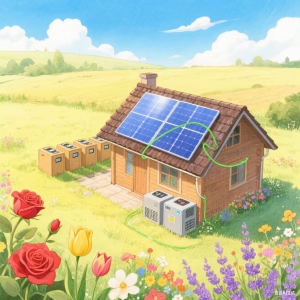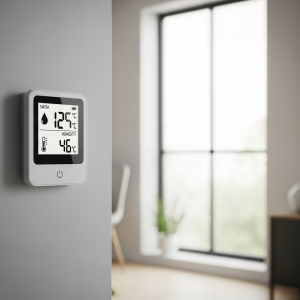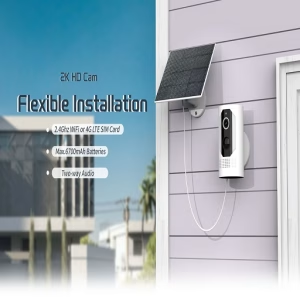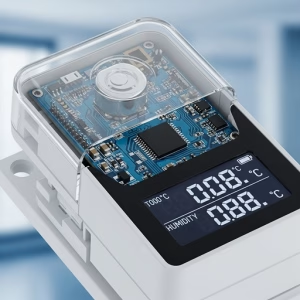High frequency off-grid inverter control Integrated machine
Introduction
An off-grid inverter system is a crucial component of standalone power systems, particularly in remote areas or places where grid power is unreliable or unavailable. These systems typically rely on renewable energy sources such as solar and wind power to generate electricity. To effectively manage and utilize this energy, a sophisticated control system is necessary.
This article delves into the intricacies of high-frequency off-grid inverter control systems, exploring their key components, operating principles, and advanced control strategies.
Core Components of a High-Frequency Off-Grid Inverter System
Power Electronic Converters:
- DC-DC Converter: Regulates the DC voltage from the energy source (e.g., battery bank) to the inverter input.
- Inverter: Converts DC power to AC power, typically at a high switching frequency to reduce the size and weight of the system.
- Transformer: Steps up or steps down the voltage as required.
Control System:
- Microcontroller or DSP: The core processing unit that executes control algorithms.
- Sensors: Measure various parameters like voltage, current, temperature, and battery state-of-charge (SOC).
- Control Algorithms: Implement control strategies to regulate power flow, optimize energy utilization, and ensure system stability.
Energy Storage System (ESS):
- Batteries: Store energy for later use, typically lithium-ion or lead-acid batteries.
- Battery Management System (BMS): Monitors and manages the battery’s health and performance.
Operating Principles of a High-Frequency Off-Grid Inverter
Power Generation:
- Renewable energy sources like solar panels or wind turbines generate DC power.
- This DC power is fed into the DC-DC converter to regulate the voltage.
Energy Storage:
- Excess energy is stored in the battery bank for later use.
- The BMS monitors the battery’s state of charge and health, and controls the charging and discharging processes.
Power Conversion:
- The DC power from the battery or renewable source is converted to AC power by the inverter.
- The inverter’s switching frequency determines the output waveform quality and system efficiency.
Power Distribution:
- The AC power is distributed to various loads, such as lighting, appliances, and motors.
- Power can also be fed back into the grid, if applicable.
Advanced Control Strategies for High-Frequency Off-Grid Inverters
Maximum Power Point Tracking (MPPT):
- Optimizes the power output from renewable energy sources by continuously tracking the maximum power point.
- Ensures efficient energy utilization and maximizes system performance.
Battery Management:
- Balances cell voltages and temperature to prevent cell damage.
- Estimates state-of-charge (SOC) and state-of-health (SOH) to optimize battery life.
- Implements charging and discharging strategies to maximize energy efficiency.
Grid Synchronization:
- Synchronizes the inverter output with the grid voltage and frequency to ensure seamless grid integration.
- Provides grid support services like reactive power control and voltage regulation.
Fault Detection and Protection:
- Monitors system parameters and triggers alarms for abnormal conditions.
- Implements protection mechanisms to prevent damage to the system and connected loads.
Challenges and Future Trends
- Reliability and Durability: Ensuring long-term reliability in harsh environments.
- Efficiency: Improving the efficiency of power conversion and energy storage.
- Cost Reduction: Reducing the cost of components and manufacturing processes.
- Grid Integration: Enhancing grid integration capabilities for seamless interaction with utility grids.
- Advanced Control Algorithms: Developing more sophisticated control algorithms for optimal performance.
Future trends in high-frequency off-grid inverter technology include:
- Integration with Smart Grid Technologies: Enabling intelligent energy management and demand response.
- Enhanced Power Quality: Improving power quality through advanced filtering techniques.
- Modular Design: Flexible and scalable systems to meet diverse needs.
- Artificial Intelligence and Machine Learning: Utilizing AI and ML for predictive maintenance and optimized control.
Conclusion
High-frequency off-grid inverter systems play a vital role in enabling the widespread adoption of renewable energy sources. By understanding the core components, operating principles, and advanced control strategies, we can design and implement efficient and reliable off-grid power systems. As technology continues to evolve, we can expect further advancements in inverter technology to drive the transition to a sustainable energy future.




